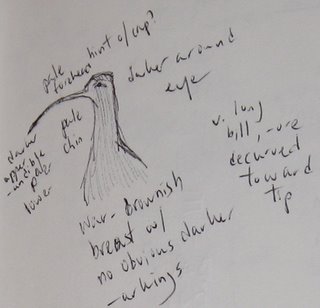
On this day in 1880, Dr. W. L. Abbott shot a Long-billed Curlew on Five Mile Beach in Cape May County. This barrier island currently hosts the Wildwoods.
Stone (1965) said the Cape May gunners called it the Sickle-bill. In Absecon, Pleasantville and Somers Point they called it Buzzard Curlew. The Pleasantville gunners also inclined towards naming it Smoker, Old Smoker or Lousy-bill; in Cape May Court House, it was Mowyer. Perhaps the Tuckerton gunners had a line in to the AOU when they called it Long-billed Curlew (Trumbull 1888).
In other words, Abbott's curlew may have been the first state record reviewed and accepted by the NJBRC (the specimen currently resides at the Academy of Natural Sciences in Philadelphia), but it was not the true first state record. The Long-billed Curlew was one of the shorebirds that was favored by market gunners and, as a result, almost shot out of existence. The Eskimo Curlew was another casualty of this profession. Alexander Wilson wrote about the regular migrations of the species through NJ in mid-May and September; he wrote in 1812. By the time W. E. D. Scott visited Long Beach in April 1877, he considered it "very rare," not to mention "shy" (Stone 1965). I guess the prospect of gunplay might make anyone shy.
Almost 100 years passed between another record from Five Mile Beach in 1898 and a record from Cape May in 1987. In the late 1980s, I found birding. I developed a fascination with shorebirds, looked at field guides and thought seeing a Long-billed Curlew would be a really neat thing. I was sure I'd have to go out west to accomplish the feat, but I was wrong. My lifer Long-billed Curlew was the one that showed up in North Wildwood (a slice of bayside on Five Mile Beach) in 2002. As remarkable as this overwintering curlew was, more remarkable was its return the following year. Then there was the one that visited an airport in Whiting, in the Pine Barrens, during the day, then lit out toward Toms River in the evening. I saw that one too (the sketch that illustrates this post is of the North Wildwood curlew).
Neighboring states tell a similar story of the Long-billed Curlew; formerly abundant, then shot out by market gunners. Long Island seems to have been another favored location (Levine 1998). It still winters in the Southeast, but NJ's current birders have been very fortunate in the recent pulse of Long-billed Curlew records. May there be more to come.
Levine, Emanuel. 1998. Bull's Birds of New York State. Comstock, Ithaca, NY.
Stone, Witmer. 1965. Bird Studies at Old Cape May: An Ornithology of Coastal New Jersey. Dover, New York, NY.
Trumbull, Gurdon. 1888. Names and Portraits of Birds Which Interest Gunners. Harper & Brothers, New York, NY.
No comments:
Post a Comment